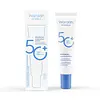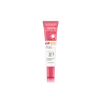What's inside
What's inside
 Key Ingredients
Key Ingredients

 Benefits
Benefits

 Concerns
Concerns

No concerns
 Ingredients Side-by-side
Ingredients Side-by-side

Water
Skin ConditioningZinc Oxide
Cosmetic ColorantC12-15 Alkyl Benzoate
AntimicrobialPropanediol
SolventMaleated Soybean Oil Glyceryl/Octyldodecanol Esters
Trisiloxane
Skin ConditioningBiosaccharide Gum-1
HumectantDibutyl Adipate
EmollientHydroxyethyl Acrylate/Sodium Acryloyldimethyl Taurate Copolymer
Emulsion StabilisingBisabolol
MaskingGlycerin
HumectantAllantoin
Skin ConditioningAvena Sativa Kernel Flour
AbrasiveCaprylhydroxamic Acid
Phenoxyethanol
PreservativeArtemisia Capillaris Flower Extract
Skin ConditioningHouttuynia Cordata Extract
Skin ConditioningHaberlea Rhodopensis Leaf Extract
Skin ConditioningCamellia Sinensis Leaf Extract
AntimicrobialPolymethylsilsesquioxane
1,2-Hexanediol
Skin ConditioningArachidyl Alcohol
EmollientButylene Glycol
HumectantTriethoxycaprylylsilane
Polyacrylate Crosspolymer-6
Emulsion StabilisingPolyhydroxystearic Acid
EmulsifyingBehenyl Alcohol
EmollientChlorphenesin
AntimicrobialArachidyl Glucoside
EmulsifyingWater, Zinc Oxide, C12-15 Alkyl Benzoate, Propanediol, Maleated Soybean Oil Glyceryl/Octyldodecanol Esters, Trisiloxane, Biosaccharide Gum-1, Dibutyl Adipate, Hydroxyethyl Acrylate/Sodium Acryloyldimethyl Taurate Copolymer, Bisabolol, Glycerin, Allantoin, Avena Sativa Kernel Flour, Caprylhydroxamic Acid, Phenoxyethanol, Artemisia Capillaris Flower Extract, Houttuynia Cordata Extract, Haberlea Rhodopensis Leaf Extract, Camellia Sinensis Leaf Extract, Polymethylsilsesquioxane, 1,2-Hexanediol, Arachidyl Alcohol, Butylene Glycol, Triethoxycaprylylsilane, Polyacrylate Crosspolymer-6, Polyhydroxystearic Acid, Behenyl Alcohol, Chlorphenesin, Arachidyl Glucoside
1,2-Hexanediol
Skin ConditioningWater
Skin ConditioningArtemisia Capillaris Flower Extract
Skin ConditioningBifida Ferment Lysate
Skin ConditioningBiosaccharide Gum-1
HumectantBisabolol
MaskingButyloctyl Salicylate
Skin ConditioningCaprylhydroxamic Acid
Caprylyl Methicone
Skin ConditioningCetyl PEG/PPG-10/1 Dimethicone
EmulsifyingCitric Acid
BufferingCyclopentasiloxane
EmollientDimethicone
EmollientDisteardimonium Hectorite
StabilisingHexyl Laurate
EmollientMineral Salts
Skin ConditioningPhenoxyethanol
PreservativePolyglyceryl-4 Isostearate
EmulsifyingPolymethyl Methacrylate
Pongamol
MaskingPropanediol
SolventPropylene Carbonate
SolventSaccharide Isomerate
HumectantSilica
AbrasiveSodium Chloride
MaskingSodium Citrate
BufferingSorbitan Olivate
EmulsifyingTetrasodium EDTA
Titanium Dioxide
Cosmetic ColorantTriethoxycaprylylsilane
Zinc Oxide
Cosmetic Colorant1,2-Hexanediol, Water, Artemisia Capillaris Flower Extract, Bifida Ferment Lysate, Biosaccharide Gum-1, Bisabolol, Butyloctyl Salicylate, Caprylhydroxamic Acid, Caprylyl Methicone, Cetyl PEG/PPG-10/1 Dimethicone, Citric Acid, Cyclopentasiloxane, Dimethicone, Disteardimonium Hectorite, Hexyl Laurate, Mineral Salts, Phenoxyethanol, Polyglyceryl-4 Isostearate, Polymethyl Methacrylate, Pongamol, Propanediol, Propylene Carbonate, Saccharide Isomerate, Silica, Sodium Chloride, Sodium Citrate, Sorbitan Olivate, Tetrasodium EDTA, Titanium Dioxide, Triethoxycaprylylsilane, Zinc Oxide
 Reviews
Reviews

Ingredients Explained
These ingredients are found in both products.
Ingredients higher up in an ingredient list are typically present in a larger amount.
1,2-Hexanediol is a synthetic liquid and another multi-functional powerhouse.
It is a:
- Humectant, drawing moisture into the skin
- Emollient, helping to soften skin
- Solvent, dispersing and stabilizing formulas
- Preservative booster, enhancing the antimicrobial activity of other preservatives
We don't have a description for Artemisia Capillaris Flower Extract yet.
Biosaccharide Gum-1 is a sugar created by fermenting sorbitol (which usually comes from potato starch!). It is known for its soothing and moisturizing properties.
Manufacturer tests show this ingredient helped reduce irritation from lactic acid by almost half and kept skin hydrated long-term as a humectant
Beyond hydration, Biosaccharide Gum-1 gives formulas a silky, non-sticky feel.
This ingredient is gentle, versatile, and suitable for all skin types.
Fun fact: Similar sugars can be found naturally in fruits like apples and pears.
Learn more about Biosaccharide Gum-1Bisabolol is famous for its skin soothing properties. It does this by blocking inflammatory signals, helping to reduce your body's reaction to irritation.
This ingredient also interferes with the process of hyperpigmentation. This can help with reducing dark spots and uneven tone.
Bisabolol is an antioxidant. Antioxidants help fight free-radicals. Free-radicals are molecules that may damage your skin cells. By fighting these free-radicals, Bisabolol may slow down signs of aging.
Studies have shown Bisabolol to have antimicrobial properties and may be a fungicide. These properties help preserve a product's shelf life.
All these properties makes bisabolol a great skin barrier helper ingredient.
Bisabolol also helps the absorption of other ingredients.
Note: Synthetic Bisabolol has been shown to be less effective.
Learn more about BisabololCaprylhydroxamic Acid is a chelating agent.
Chelating agents help prevent metal ions from binding to other ingredients. This helps prevent unwanted reactions and effects from using the product.
Caprylhydroxamic Acid is often used with natural antimicrobial products as an alternative to preservatives.
Learn more about Caprylhydroxamic AcidPhenoxyethanol is a preservative that has germicide, antimicrobial, and aromatic properties. Studies show that phenoxyethanol can prevent microbial growth. By itself, it has a scent that is similar to that of a rose.
It's often used in formulations along with Caprylyl Glycol to preserve the shelf life of products.
Propanediol is an all-star ingredient. It softens, hydrates, and smooths the skin.
It’s often used to:
Propanediol is not likely to cause sensitivity and considered safe to use. It is derived from corn or petroleum with a clear color and no scent.
Learn more about PropanediolTriethoxycaprylylsilane is a silicone used to bind and stabilize ingredients.
As an emulsifier, it helps prevent ingredients from separating. This can help elongate the shelf life of products.
Triethoxycaprylylsilane is often used to coat mineral sunscreens ingredients to help give a better feel. It also helps reduce oxidative stress in sunscreens.
Learn more about TriethoxycaprylylsilaneWater. It's the most common cosmetic ingredient of all. You'll usually see it at the top of ingredient lists, meaning that it makes up the largest part of the product.
So why is it so popular? Water most often acts as a solvent - this means that it helps dissolve other ingredients into the formulation.
You'll also recognize water as that liquid we all need to stay alive. If you see this, drink a glass of water. Stay hydrated!
Learn more about WaterZinc Oxide is a mineral broad-spectrum UV filter; it is the broadest UVA and UVB reflector approved by the FDA. It also has skin protectant and skin soothing properties.
Zinc oxide is one of the most effective broad-spectrum UV filters. It protects against UVB, UVAII, and UVAI. In comparison to its counterpart titanium dioxide, zinc oxide provides uniform and extended UVA protection.
Another great benefit? This ingredient is highly photostable so it won't degrade easily under sunlight.
A common myth is that mineral UV filters are widely believed to primarily reflect UV light.
However, modern research shows titanium dioxide absorbs UV radiation like chemical filters (~95% absorption & 5% reflection).
Zinc oxide has great skin soothing properties so you'll likely find this in sunscreens formulated for sensitive skin or babies/children. It is unlikely to cause "eye sting" like other sunscreen ingredients.
Regulatory agencies consider zinc oxide to be non-toxic and safe. It has also been shown to not penetrate the skin.
Unfortunately, this ingredient does leave a visible white cast. This is why mineral sunscreens are often less cosmetically elegant than chemical or hybrid ones.
In cosmetics, zinc oxide can be found in both non-nano and nano-sized forms. The nano version is used to reduce white cast and improve the texture of sunscreen formulas.
There are ongoing concerns surrounding nano-zinc oxide's impact on marine ecosystems and whether it can be absorbed into skin.
Regarding marine ecosystems and coral reefs, there is no conclusive evidence that any form of zinc oxide (or any other sunscreen ingredients) will cause harm. The science is still developing but many consumers are keeping a close eye on this issue.
Please note, many destinations have reef-safety sunscreen rules. For instance, the U.S. Virgin Islands advises all visitors to use non-nano mineral sunscreens.
There has also been some stir about whether micronized or nano zinc oxide has potential photoxicity and absorption through the skin/lungs.
An in-vitro (done in a test tube or petri dish) study demonstrated micronized zinc oxide to have potential phototoxicity. There's no need to fret; the EU Commission's Scientific Committee on Consumer Safety has stated, "The relevance of these findings needs to be clarified by appropriate investigations in vivo." Or in other words, further studies done on living organisms are needed to prove this.
Current research shows zinc oxide nanoparticles do not penetrate intact or sunburned skin. They either remain on the surface or in the outermost layer of dead skin (stratum corneum).
Zinc oxide is one of only two classified mineral UV filters with titanium dioxide being the other one.
Fun fact: Zinc has been used throughout history as an ingredient in paint and medicine. An Indian text from 500BC is believed to list zinc oxide as a salve for open wound. The Ancient Greek physician Dioscorides has also mentioned the use of zinc as an ointment in 1AD.
Learn more about Zinc Oxide